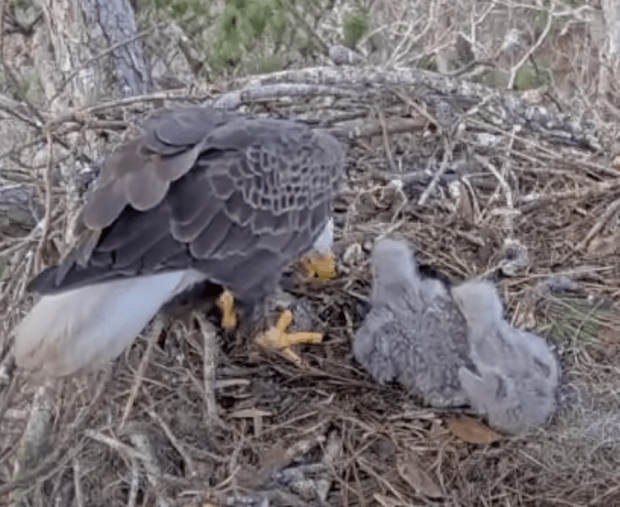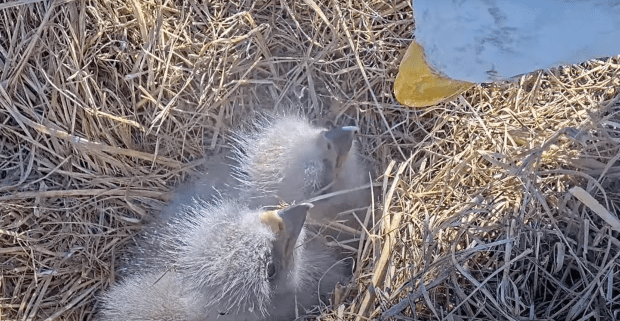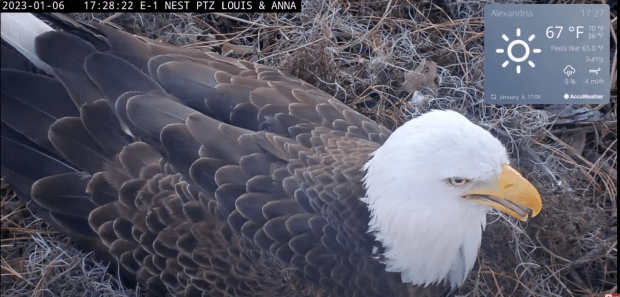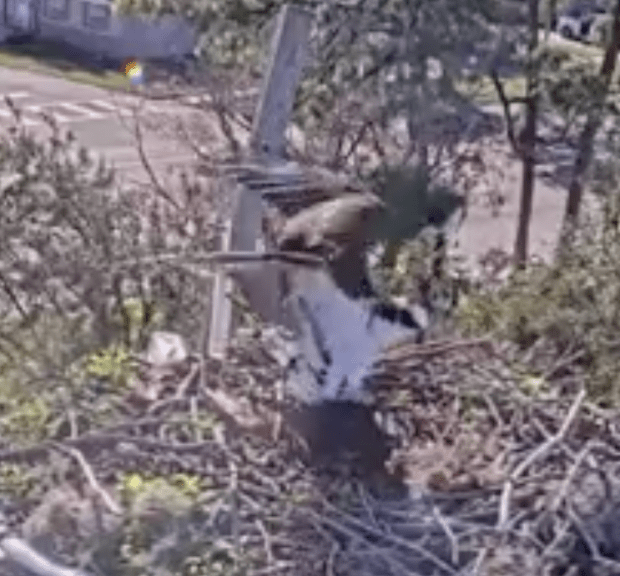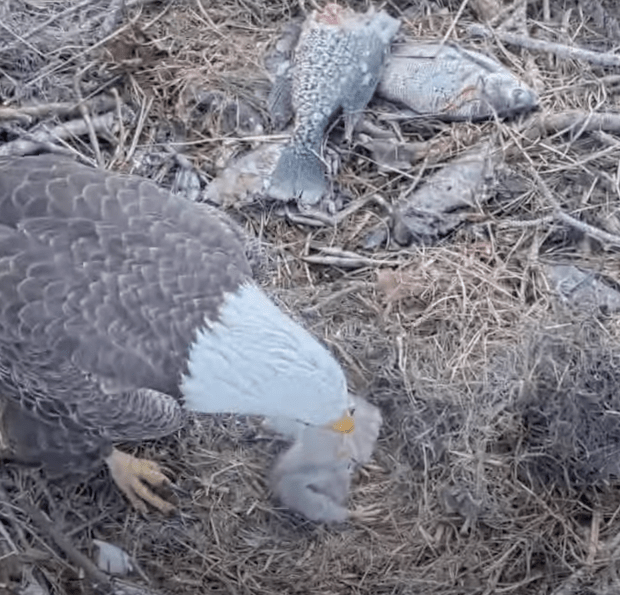4 August 2023
Good Morning Everyone!
Things are starting to quiet down a bit. There are a few more birds left to fledge. We have to imagine that in 2-4 weeks, all of them will be on their way to their winter homes. For the juvies, what an adventure will be in store for them. Let us all hope that those who lived to fledge this year will make it and return in 2 years to try and find a mate and raise their own families.
The images are not good as these two are moving about, but even at a year old (Missey was found in July 2022 and Lewis in August 2022) and not siblings, these two could not be closer. They play together constantly and wash one another, sleep beside one another, and hold paws. I am continually amazed at their remarkable bond.


These two will shortly have a ‘new sister’. I hope that they learn to love her. Since last fall, I have cared for a feral cat, a Calico. This late spring, I began to call her and move the food dish closer and closer to the garden door. At the beginning of July, I accelerated the feedings and attention. The goal (at first) was to trap her and take her to be vaccinated, dewormed, and fixed. Then release her back into the wild. That shifted when she allowed me to stroke her and scratch her head. Now I sit beside her while she eats. We have a trap and release programme in our City for feral cats, and because of Lewis and Missey, I also have a wonderful vet who has offered a significant discount since Calico is a feral. So…the race is on to see who is first. The vet can see her on the 14th for all the health checks, vaccines, deworming, etc but not the surgery. The waiting list for the operation is currently at the end of November. I am unclear about the trap and release programme openings. They will call.
Our neighbourhood has two other feral cats, but this petite female has won our hearts and minds. Her spending another winter in -35 C temperatures doesn’t sit right. It is incomprehensible. (We hope to trap the other two and get them to the Humane Society to be fostered for socialisation and adoption). So, it could be the 14th when Calico joins us. Wish us luck as we integrate her into the family.
Lewis watching Calico eat.


My father loved animals – and could not stand to see one go hungry. He was the one that took care of all the strays in our neighbourhood when I was young, and that practice continued until he died in his 90s. People knew, and they would ‘dump’ their cats at our house, knowing he would care for them until he could find good homes. It feels good to carry on his legacy.
There is a lot of news about rescues, unusual bird sightings, and near tragedies. I am going to share a little more with you than usual today. It is all very interesting and should motivate us to get out and help – including stopping people from cutting down trees where there are active nests. More birds are getting caught in fishing lines, not just our raptors. This is a massive problem in North America.
We can help by committing to cleaning up a specific area once or twice a year. You can do this alone or organise a group. Wear latex gloves and have a container that will not allow you to be pricked by the hooks. The problem, then, is how to dispose of this mess. Every lake area should place containers for people to leave their broken lines and hooks or dispose of found debris. If not, contact your local wildlife rehabber to ask how to dispose of the items safely so they do not return to the environment.

Is it really possible not to see one of those huge Bald Eagle nests in a tree?

It has been three years since the Dolan fire swept through Big Sur. The new release pen for the condors is now open.


How are the birds adapting to survive in the heat? This is a great article by Bay Nature. Please have a read…I learned so much. Tactical pooping?

It isn’t about raptors but it is about the growing threats to wetlands which are essential for our birds and other wildlife. So what did happen to Grace? and her wetlands?
Lots of bird counts going on right now. Many are coming up with some surprises. These are Red-Billed Cloughs – pronounced ‘Chuff’. They live along the western shores of the UK and Ireland.
In 2002 a pair of Cloughs was noticed in Cornwall. It was later discovered that they had arrived from Ireland. The population has grown. These birds eat insects and larvae and are often mistaken for Crows. Aren’t they gorgeous with their shiny scarlet bills and legs? Even those yellow Darvin Bands look perfectly selected, but the deep ebony plumage with that hint of blue-green on the wings is also so dramatic. Notice the curve of the long beak. It is perfect for going after the insects and larvae that the Cloughs eat.

Big Red and Arthur’s 2022 fledgling L3 was released on Wednesday. A bittersweet moment. So happy to see her with her beautiful red tail flying in the wild but so sad for her sibling M2 who died of a collision on the Cornell Campus the same day.

It is relatively quiet in the nests. There are a few more birds to fledge, some raptors thinking about eggs in Australia, and now beaking at the Sea Eagle nest. Quiet is nice for a change.
Around the nests:
WRDC: I have not watched this nest for some time since R4 and R5 fledged, but goodness – today, R5 grabbed a fish right out of Rose’s talons as she flew by. Way to go, R5 – didn’t even drop it. But this was only the beginning. Rose tried to steal the fish, but R5 held strong and then R4 appeared in the nest. These two are getting really good training for when they are out living independent lives.

Hellgate Canyon: Marlene Harris got a great screen capture of Iris. She is still here – and should be for the rest of August! Gosh, isn’t she looking good?

Let’s go to some good news coming out of Fortis Exshaw from ‘H’: “
First, the news: they have names! Names for the 47-day-old osplets: Chick #1, believed to be a female, has been named Banff, after the nearby Banff National Park in Alberta. Chick #2, believed to be male, has been aptly named Jasper Junior, or ‘JJ’ for short. In addition, Mr. O, the family’s savior who came on the scene to help Louise shortly after Louise’s long-time mate Jasper disappeared, has been named O’Hara, after Lake O’Hara in Yoho National Park, British Columbia. Lake O’Hara is located about six miles from Lake Louise in Alberta.There were no fish delivered until the afternoon. Banff and JJ had eaten well on 8/2, so we weren’t worried. Intruders may have been the reason for Louise and O’Hara not bringing in fish. Both Louise and O’Hara had flown to the nest a few times to ward off intruders. Then, as if it had been choreographed, two fish were delivered eight minutes apart. (Conversation between Louise and O’Hara: “OK, O’Hara, it looks like the intruders have vacated the area, so let’s feed the kids.” O’Hara replied, “Yes, Louise, let’s do this!”). O’Hara delivered a nice size fish at 1405, and it was claimed by Banff. Then, Louise delivered an even larger fish at 1413. Banff abandoned her fish in an attempt to grab the new fish. So Louise said, “Okay, kiddo, then I’m going to take the fish you had,” and she jumped over Banff and picked up the first fish. But, Banff said, “No, wait Mom, that’s mine,” and reclaimed it. That made it easy for JJ who was able to claim the second fish. Perfect! Each sibling ate their entire fish and had huge crops. (the quality of the images is poor, as parts of the video screen remain severely pixelated)”



Patchogue: I could stare at Mini all day long. Soon she will be gone and these moments are very precious. What a beautiful bird she is.



Three fledglings were at the nest Friday. (I do not know the two older siblings well enough to tell if both have been coming to the nest or only one of them.) Mini was wanting a fish, and so were they.

Steelscape: Still on highlights.
MN Landscape: Hot. Chick is trying to stay cool and hoping for fish.


Boulder County: Only cam #2 is operating.


Finland #1: No one on the net and then they see Dad flying in with breakfast. Dad really stretches to try and protect his legs.


Finland #4. Wet and hungry and fish crying – very loud!

Ilomantsin: Wet and hungry, too. Dad leaves after bringing in a breakfast fish. The other sibling is hoping he returns soon with one for it.

Kuopio: Oh, the winds are powerful. One chick has a nice crop, and another digs into a fish. Three is hoping more will arrive.


Port Lincoln: Dad continues to bring Mum fish as she stays on the nest. When will we have that first egg?

Time to return to ‘H’s other reports:
Forsythe: Ollie is very hungry. Oscar delivered one fish to the nest on 8/3, at 0724. Both Owen and Ollie vied for the fish, with Owen the victor. Owen took her fish off the nest, and to the best of my knowledge was not seen on camera the rest of the day. The last time Ollie had a fish to eat (that we know of) was at 0920 on 8/1 (Ollie did acquire one fish on 8/2, but lost it). Is Owen being fed off-nest? If so, it wouldn’t make sense for Oscar not to bring fish to the nest for his other fledgling. Perhaps Owen has learned to catch her own fish. There are two ‘ponds’ near the nest, and basically they are simply holes in the marsh that trap water, and perhaps small fish as the tide goes out. Ollie was seen diving into those ponds three or four times on 8/3. She apparently did not catch a fish. Ollie knows that she has to try to feed herself at this point to survive. This is a sad situation. I hope Oscar will bring Ollie an early breakfish today.
And great news just coming in from ‘H’: “Oscar delivered a small whole fish to Ollie at the nest at 0926.”




Osoyoos – Olsen delivered 6 fish for his family, and Soo also fed a meal from a leftover fish. Junior has been starting to exercise his wings a bit.


Barnegat Light – Lol, Dorsett is a real beach kid. She simply loves spending time along the shore of the Bay. Dorsett worked up a voracious appetite, and made sure she was on the nest at supper time when Daisy served up her daily bluefish!


Thanks so much ‘H’ for all your reports today!
Let’s continue to send out most positive wishes to all those nests that continue to struggle.
Despite it being nearly the end of Osprey season in the Northern Hemisphere, I want to recommend one of the best Osprey books on the market. In Canada, it is $20 plus $3.99 shipping. This is an amazing price.
Tim Mackrill graduated from my old alma mater in the UK, the University of Leicester. He managed the Rutland Water Project and wrote the incredible history of their Ospreys for ten years before moving over to the Roy Dennis Wildlife Foundation. His speciality is Osprey migration. The images are excellent; thorough information covers everything from the different sub-species of ospreys and their plumage to their habits, breeding, migration, translocations, building nests, and everything to know about the chicks from breeding, development, and fledging. Tim did not miss a beat when writing this easy-to-understand book on our favourite raptor. If you only have one reference book for ospreys on your shelf – this is the one I recommend.

Thank you so very much for being with me today. Take care. See you soon!
Thank you to the following for their notes, posts, videos, and streaming cams that helped me to write my blog today: ‘H’ – for your great reports and the cover image, CBC New Brunswick, Joan Dice and the Trio and Other Eagle Nest News, Ventana Wildlife Society, The Narwhal, BirdGuide.Com, Cornell Bird Lab, WRDC, Marlene Harris and Cornell Hawk Chatters, Fortis Exshaw, PSEG, MN Landscape, Boulder County, Finnish Osprey Foundation, Port Lincoln Ospreys, Forsythe, Osoyoos, NJ Wildlife Conserve Foundation, and Tim Mackrill and the RSPB.























































































































